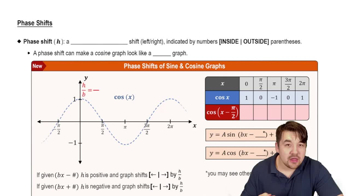Table of contents
- 0. Review of College Algebra4h 43m
- 1. Measuring Angles39m
- 2. Trigonometric Functions on Right Triangles2h 5m
- 3. Unit Circle1h 19m
- 4. Graphing Trigonometric Functions1h 19m
- 5. Inverse Trigonometric Functions and Basic Trigonometric Equations1h 41m
- 6. Trigonometric Identities and More Equations2h 34m
- 7. Non-Right Triangles1h 38m
- 8. Vectors2h 25m
- 9. Polar Equations2h 5m
- 10. Parametric Equations1h 6m
- 11. Graphing Complex Numbers1h 7m
4. Graphing Trigonometric Functions
Graphs of Tangent and Cotangent Functions
Problem 4.21a
Textbook Question
Graph each function over a one-period interval.
y = (1/2) csc (2x + π/2)
 Verified step by step guidance
Verified step by step guidance1
Identify the function: The given function is \( y = \frac{1}{2} \csc(2x + \frac{\pi}{2}) \). The cosecant function, \( \csc(\theta) \), is the reciprocal of the sine function, \( \sin(\theta) \).
Determine the period of the function: The standard period of \( \csc(x) \) is \( 2\pi \). For \( \csc(bx) \), the period is \( \frac{2\pi}{b} \). Here, \( b = 2 \), so the period is \( \frac{2\pi}{2} = \pi \).
Find the phase shift: The phase shift is determined by the expression inside the cosecant function, \( 2x + \frac{\pi}{2} \). Set \( 2x + \frac{\pi}{2} = 0 \) to find the phase shift. Solving for \( x \) gives \( x = -\frac{\pi}{4} \).
Determine the vertical shift and amplitude: The function \( y = \frac{1}{2} \csc(2x + \frac{\pi}{2}) \) has a vertical stretch by a factor of \( \frac{1}{2} \). There is no vertical shift since there is no constant added or subtracted from the function.
Graph the function: Start by graphing \( y = \sin(2x + \frac{\pi}{2}) \) over one period \([0, \pi]\). Identify the asymptotes where the sine function is zero, as these are the undefined points for the cosecant function. Then, sketch the \( \csc \) function by drawing curves that approach the asymptotes, reflecting the reciprocal nature of the sine function.
Recommended similar problem, with video answer:
 Verified Solution
Verified SolutionThis video solution was recommended by our tutors as helpful for the problem above
Video duration:
0m:0sPlay a video:
Was this helpful?
Key Concepts
Here are the essential concepts you must grasp in order to answer the question correctly.
Cosecant Function
The cosecant function, denoted as csc(x), is the reciprocal of the sine function. It is defined as csc(x) = 1/sin(x). The cosecant function has a range of all real numbers except for the interval (-1, 1), and it is undefined wherever the sine function is zero. Understanding the properties of the cosecant function is essential for graphing it accurately.
Recommended video:

Graphs of Secant and Cosecant Functions
Period of Trigonometric Functions
The period of a trigonometric function is the length of one complete cycle of the function. For the cosecant function, the period is determined by the coefficient of x inside the function. In the case of y = (1/2) csc(2x + π/2), the period is π, since the period of csc(kx) is 2π/k, where k is the coefficient of x.
Recommended video:

Period of Sine and Cosine Functions
Phase Shift
Phase shift refers to the horizontal shift of a trigonometric function along the x-axis. It is determined by the constant added to the variable inside the function. In the function y = (1/2) csc(2x + π/2), the phase shift can be calculated by setting the inside of the function equal to zero, leading to a shift of -π/4 to the left. This shift affects the starting point of the graph.
Recommended video:

Phase Shifts

 5:43m
5:43mWatch next
Master Introduction to Tangent Graph with a bite sized video explanation from Nick Kaneko
Start learningRelated Videos
Related Practice














